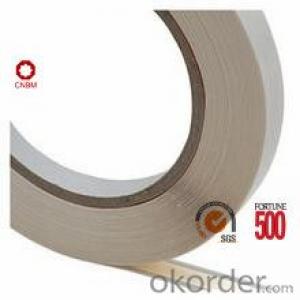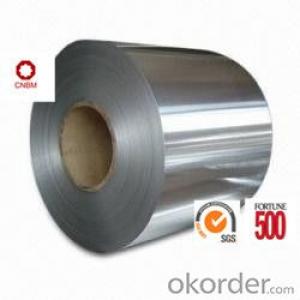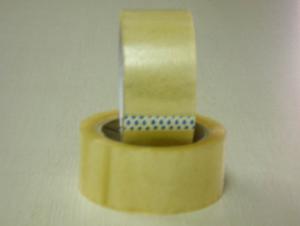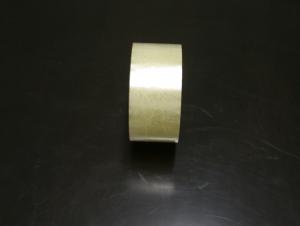Discount Packaging Tape Tulsa - BOPP Adhesive Tape for Packing
- Loading Port:
- Shenzhen
- Payment Terms:
- TT
- Min Order Qty:
- 3000USD roll
- Supply Capability:
- 1x 20 ft roll/month
OKorder Service Pledge
OKorder Financial Service
You Might Also Like
Quick details:
Material: BOPP
Use: Carton Sealing
Adhesive Side: Single Sided
Adhesive: Acrylic
Adhesive Type: Water Activated
Design Printing: Offer Printing
Place of Origin: China (Mainland)
color: clear, super clear, crystal clear, red, blue, brown, yellow, green etc
Specifications:
| ItemNo. | Carrier | Adhesive | Total Thickness | Initial Tack | Peel Adhesion | Holding Power | Tensile Strength | Elongation |
| BP-40 | BOPP film | water based acrylic | 40 micron | >18# | 0.5kgf/25mm | >24h | >30N/cm | <180% |
| BP-45 | BOPP film | water based acrylic | 45 micron | >18# | 0.5kgf/25mm | >24h | >30N/cm | <180% |
| BP-50 | BOPP film | water based acrylic | 50 micron | >20# | 0.5kgf/25mm | >24h | >30N/cm | <180% |
| BP-65 | BOPP film | water based acrylic | 65 micron | >24# | 7.88N/25mm | >40h | >30N/cm | <180% |
Application:
Bopp tape is mainly for Carton sealing & packing, Light duty packaging, bundling, holding, and other office & household use.
Packing:
Paper Core ID: 76mm
Jumbo size: 0.99m x 1800m, 1.22m x 1800m, 1.51m x 1800m
Cut roll size: As per customer's requirement
Cut rolls: 6 rolls per shrink, 36/54/72 rolls per carton with or without pallet
Jumbo rolls & log rolls: Packed with kraft paper and stretch wrap film, with or without pallet
Company Advantages:
1. Stable financial status and sound reputation as a state invested corporation under the direct administration of the State Council of PRC;
2. CNBM’s world wide influence as one of the 500 global fortunes specializing in building materials including adhesive tapes;
3. More than a decade’s exporting experience and technology in adhesive tape industry;
4. Preferencial shipping channels, with a separate team dealing with shipping.


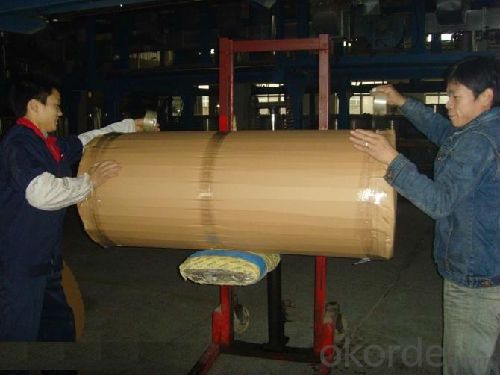


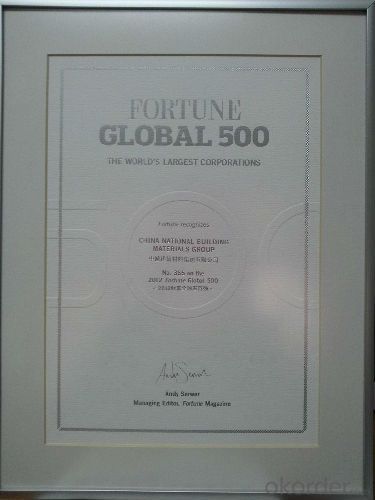

- Q: Can packaging tape be used for sealing construction materials or tools?
- Yes, packaging tape can be used for sealing construction materials or tools. Packaging tape is designed to securely seal boxes and packages, so it can also be used to seal construction materials or tools. It provides a strong and durable bond, making it suitable for sealing various types of materials such as wood, metal, plastic, or concrete. However, it is important to consider the weight and the nature of the materials being sealed. For heavier or more demanding construction applications, it may be more appropriate to use specialized tapes or adhesives specifically designed for construction purposes.
- Q: Can packaging tape be used for sealing packages with delicate fabrics or clothing?
- Sealing packages containing delicate fabrics or clothing with packaging tape is possible. However, it is crucial to exercise caution and implement specific precautions to ensure the protection of these fragile items. Here are some tips to guarantee safe packaging: 1. Opt for a broad, transparent packaging tape: Select a tape that provides a larger adhesion surface area due to its width. Transparent tape is preferable as it reduces the risk of leaving visible residue or marks on the fabric. 2. Apply a double layer of tape: Enhance the strength and security of the package by using two layers of packaging tape. This will help prevent accidental peeling during transit. 3. Securely wrap the delicate items: Before sealing the package, make sure to wrap the delicate fabrics or clothing in a protective layer such as tissue paper or bubble wrap. This additional layer will act as a buffer, safeguarding the items from potential damage caused by the tape. 4. Avoid excessive tension: Exercise caution while sealing the package and avoid pulling the tape too tightly. Excessive tension may stretch or distort the fabric, potentially damaging the delicate item. 5. Explore alternative options: For particularly fragile or valuable delicate items, it may be beneficial to consider alternative packaging materials such as acid-free tissue paper or garment bags. These options offer additional protection and are specifically designed for preserving delicate fabrics and clothing. Ultimately, while packaging tape can be utilized for sealing packages containing delicate fabrics or clothing, it is essential to handle the items with care and implement appropriate measures to minimize the potential for damage during the packaging process.
- Q: Can packaging tape be used for sealing wooden crates?
- Yes, packaging tape can be used for sealing wooden crates. It provides a strong and secure bond, ensuring that the crate remains sealed during transportation or storage. Packaging tape is designed to adhere to various surfaces, including wood, making it an effective choice for sealing wooden crates. However, it is important to consider the weight and size of the crate before solely relying on packaging tape. For heavier or larger crates, it may be necessary to reinforce the seal with additional methods such as nails or screws.
- Q: How do I prevent packaging tape from unraveling?
- Here are some helpful tips to prevent packaging tape from unraveling: 1. Ensure a clean surface: Prior to applying the tape, ensure that the surface is clean and free from any dirt or debris. This will enhance the tape's adhesion and prevent it from unraveling. 2. Invest in high-quality packaging tape: Opt for durable packaging tape that possesses a strong adhesive. Cheaper or low-quality tapes tend to unravel more easily. 3. Cut the tape correctly: When cutting the tape, utilize a sharp knife or scissors to create a neat edge. This will eliminate any loose ends that may lead to unraveling. 4. Apply ample pressure: Once the tape is affixed to the surface, exert firm pressure along its entire length. This will guarantee proper adhesion and minimize the chances of unraveling. 5. Overlap the tape: To provide additional support, slightly overlap the tape onto itself. This creates a stronger bond and reduces the likelihood of unraveling. 6. Properly store the tape: When not in use, store the tape in a cool and dry place, away from direct sunlight. Extreme temperatures and moisture can weaken the adhesive, resulting in tape unraveling. 7. Utilize tape dispensers: Consider using a tape dispenser equipped with a built-in cutter. This will not only simplify the cutting process but also yield a clean edge, preventing unraveling. By adhering to these guidelines, you can significantly reduce the risk of packaging tape unraveling and ensure that your packages remain securely sealed.
- Q: Does packaging tape have any specific certifications or standards?
- Packaging tape possesses specific certifications and standards. Various organizations and standards establish guidelines for packaging materials, including packaging tape. One of the most prevalent certifications for packaging tape is the ISO certification from the International Organization for Standardization. ISO establishes quality management system standards, and packaging tape can acquire certification under ISO 9001:2015 to ensure that it meets specific quality criteria. Apart from ISO certification, packaging tape can also conform to industry-specific standards like those set by ASTM International or European Union directives. ASTM International develops and publishes technical standards for a wide range of materials, including packaging tape. These standards guarantee that the tape satisfies particular requirements concerning strength, adhesion, and durability. Furthermore, certain packaging tapes may possess certifications associated with their environmental impact. For instance, specific tapes may be certified as recyclable, biodegradable, or made from sustainable materials. Organizations like the FSC or the SFI grant these certifications to promote responsible forestry practices. It is crucial to note that not all packaging tapes will possess certifications or adhere to specific standards. However, if a packaging tape does have certifications or complies with certain standards, it indicates that the product satisfies particular quality, performance, or environmental criteria.
- Q: Can packaging tape be used for sealing packages with sharp or pointed objects?
- Indeed, packaging tape is capable of sealing packages that contain sharp or pointed items. Its purpose is to create a reliable seal for packages, effectively keeping together those that hold sharp or pointed objects. Nonetheless, it is crucial to ensure that the tape is tightly fastened and covers all edges and corners of the package to avoid any potential harm or damage during handling or transportation. Moreover, it is advisable to apply multiple layers of tape or employ supplementary protective measures, like cushioning materials, to reinforce the security and safeguard the sharp or pointed items enclosed within the package.
- Q: How do I prevent packaging tape from losing its adhesive properties?
- To prevent packaging tape from losing its adhesive properties, it is important to store it in a cool, dry place away from direct sunlight and extreme temperatures. Additionally, ensure that the surface where the tape is applied is clean and free from any dust, oil, or moisture, as these can compromise the adhesive. Applying the tape firmly and evenly, avoiding excessive stretching, can also help maintain its adhesive strength.
- Q: I saw a lot of different sizes of sealing tape on the Internet. Some are very thick and some are thin. Will the thickness of the same number be the same in the same number of yards? Some 100Y have around 1.5cm of the flesh, but some 100Y only about 0.7cm of the flesh, what is this possible? Or is it true or false? Ask the personage inside course of study to help solve!
- 100 yards, 150 yards, can be found everywhere! To do adhesive tape, we must find good faith partners! Professional to undertake all kinds of sealing tape production and wholesale
- Q: Is packaging tape safe to use on stainless steel?
- Yes, packaging tape is generally safe to use on stainless steel as it does not usually cause any damage or leave adhesive residue. However, it is always recommended to test a small, inconspicuous area first to ensure there are no adverse reactions or issues with the specific type of tape being used.
- Q: Does packaging tape come in different dispenser designs for ergonomic use?
- Different dispenser designs for ergonomic use are available for packaging tape. Various manufacturers offer dispenser options that are specifically created to provide comfort and ease of use during extended periods of usage. These designs often incorporate features like cushioned handles, ergonomic grips, and adjustable tension control to minimize strain and fatigue on the hand and wrist. Moreover, certain dispensers may possess a lightweight and compact design, making them more manageable and maneuverable. The objective of these ergonomic dispenser designs is to enhance productivity and lower the likelihood of injuries or discomfort commonly associated with repetitive tape dispensing tasks.
1. Manufacturer Overview
| Location | Fujian, China |
| Year Established | 1994 |
| Annual Output Value | Above US$ 1000 Million |
| Main Markets | Southeast Asia; South America; Eastern Europe; North America; Northern Europe; South Asia; Western Europe; Africa; Mid East |
| Company Certifications |
2. Manufacturer Certificates
| a) Certification Name | |
| Range | |
| Reference | |
| Validity Period |
3. Manufacturer Capability
| a) Trade Capacity | |
| Nearest Port | Shenzhen |
| Export Percentage | 41% - 50% |
| No.of Employees in Trade Department | 101-200 People |
| Language Spoken: | English; Chinese |
| b) Factory Information | |
| Factory Size: | Above 10,000 square meters |
| No. of Production Lines | Above 10 |
| Contract Manufacturing | produce single sided tapes,double sided tapes, masking tape, Opp tape |
| Product Price Range | Low; Average |
Send your message to us
Discount Packaging Tape Tulsa - BOPP Adhesive Tape for Packing
- Loading Port:
- Shenzhen
- Payment Terms:
- TT
- Min Order Qty:
- 3000USD roll
- Supply Capability:
- 1x 20 ft roll/month
OKorder Service Pledge
OKorder Financial Service
Similar products
Hot products
Hot Searches














